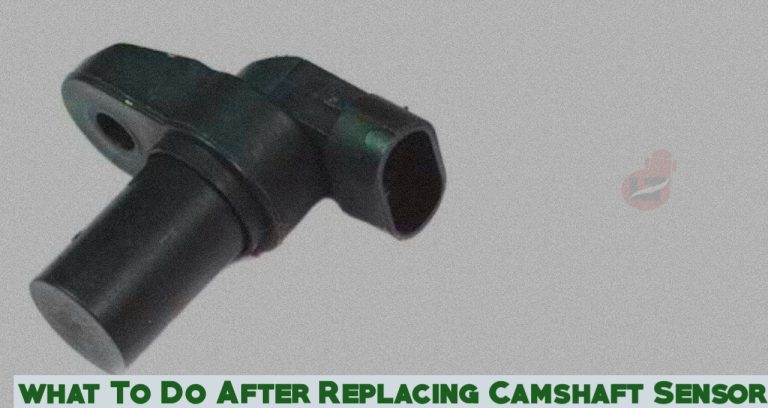After replacing the camshaft Sensor on your vehicle, you must take further actions to ensure everything is functioning correctly and to avoid future troubles.
When your camshaft sensor goes bad, you’ll be notified on your dashboard with a check light warning that one or more of the camshaft sensors are bad.
Alternatively, you can notice signs such as reduced fuel mileage, stalling, engine misfiring, etc., indicating a sensor replacement.
However, after replacing the camshaft Sensor, the troubles might persist, leaving the driver confused about what might cause the problem and what to do next.
The answer to what to do after replacing the camshaft sensor is to reset the error codes and reprogram the engine computer to work with the new sensor.
In this article, we’ll discuss camshaft sensors and what to do after replacing a camshaft sensor.
What is a Camshaft Sensor?
A camshaft sensor is an electronic device that monitors the location and rotational speed of the camshaft.
The sensor relays the data to the engine control unit, which uses the information to adjust the engine timing.
This will help release fuel mixtures and produce sparks into the cylinder, determining how smoothly the engine will perform.
If the camshaft sensor becomes terrible, it’ll relay wrong information to the ECU, which can cause issues such as stalling, engine misfiring, or total engine shutdown.
In another case, the camshaft sensor may also monitor engine components such as your coolant temperature or oil pressure.
You can see that a functional camshaft sensor is required for a good driving experience.
What To Do After Replacing Camshaft Sensor
The camshaft sensor’s task cannot be overlooked, as it helps the ECU adjust the timing and fuel injection systems.
While there are times when the ECU will automatically adjust to the newly installed camshaft sensor, you must reset your computer to ensure accurate results.
Failure to do this will result in your check engine light coming on, reduced engine performance, an unresponsive engine, stalling, or engine misfiring.
You can reprogram the sensors using an OBD-II scanner. This tool can fetch and clear existing codes on the engine computer.
- Connect the OBD-II scanner to your car diagnostic port
- turn your ignition to ON or Start it
- It’ll read the error codes on the car
- From the option, click on “clear codes” or “reset” (the option might differ from the OBD-II model)
- You can disconnect the scanner and check if the check engine light has disappeared.
If the engine light comes back on a few minutes after the reset, you should check the camshaft sensor’s wiring harness.
It could also be that the replaced sensor is faulty and probably needs a replacement, or other damage has been done during the installation.
I’ll advise you to leave the task of camshaft sensor replacement to a professional mechanic because it’s a complex component that must be installed properly.
I’d also like to add that camshaft sensors don’t develop issues too often, but factors such as vibration, excessive heat, debris, and physical impact could cause them to fail prematurely.
How to Reset Camshaft Position Sensor
To reset a newly installed camshaft position sensor to work with the ECU, you’ll need to use an OBD-II scanner.
This is necessary to prevent the computer from receiving signals from the former bad sensor and reconfigure it to obtain correct information from the newly installed camshaft sensor.
- Firstly, Connect the OBD-II scanner to your car diagnostic port
- Turn your car keys to start or turn it on
- Allow the scanner to read the error codes on the car system
- From the option, click on “clear codes” or “reset” (the option might differ from the OBD-II model)
Using the scanner, you can check your buyer’s guide for the specific options to clear diagnostic codes from your car.
Alternatively, if you don’t own an OBD-II scanner, you can remove the negative battery terminal of your car to reset the sensor.
Removing the negative terminal for at least 10 minutes and putting it back will drain energy stored on the computer, making it reset automatically.
Symptoms of a Bad Camshaft Sensor
Several symptoms often accompany a bad camshaft sensor. However, these symptoms might be synonymous with other car faults.
- The check engine light illuminates
- Engine Misfiring
- Stalling
- Rough Idling
- Reduced fuel mileage
- Engine power loss
- Sputtering
FAQs
Do you have to reprogram a camshaft sensor?
Reprogramming a new camshaft sensor will help the ECU collect information, unlike the lousy camshaft sensor.
How long does it take for a camshaft sensor to reset?
In most cases, a new camshaft sensor will not reset itself to work with the control unit, but using an OBD-II scanner, it can be reset in 5 minutes.
How do you test a new camshaft sensor?
Should you disconnect the battery when changing the camshaft position sensor?
You don’t need to disconnect your battery when changing the camshaft position sensor, but doing that will help you reset it faster to work with the ECU.
This will eliminate the problem of the check engine light staying on even after replacing the sensor.
As an Amazon Service LLC Program Associate, V. Auto Basics earns from qualifying purchases. See Our Affiliate disclaimer.
